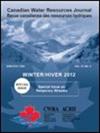森林集水区溪流中太阳辐射热通量的时空变化
IF 1.7
4区 环境科学与生态学
Q3 WATER RESOURCES
引用次数: 2
摘要
摘要太阳辐射通常是对溪流热量预算的最大贡献通量,其估计对于使用基于过程的模型预测溪流水温至关重要。本研究的目的是量化传输系数的空间(不同溪流大小的站点间比较,河段范围内的站点内比较)和时间(季节、每日和每小时尺度)变化,传输系数代表到达溪流的入射太阳辐射的比例。我们在一个有气象站的开放场地和位于米拉米奇河流域(加拿大)三条不同大小溪流中的小气候场地测量了太阳辐射。在夏季,到达溪流的每日入射太阳辐射的百分比从小型源头溪流(Trib)的8%到中型溪流(CatBk)的43%不等,在宽阔的河流(LSWM)中接近100%。我们观察到,由于树冠封闭程度非常不同,不同河流尺寸的传输系数之间的变化最大(变化范围=92%),其次是横向位置之间(左右岸之间的变化范围=21%)和纵向位置之间(上游和下游站点之间的变化范围=11%)的河段尺度变化,如在中等大小的流处测量的。时间变异性在季节尺度上最大,5月至9月间,小源头河流的传输系数变化了23%。透射系数的小时变异性(即与不同的太阳角相关)超过了日变异性(如与不同的云量条件相关),在小时时间尺度上计算的变异系数是在日时间尺度上的三到五倍。总的来说,这项研究提供了关于处理太阳辐射的空间和时间变化的见解,这将为改进基于过程的流温度模型提供进一步的见解。本文章由计算机程序翻译,如有差异,请以英文原文为准。
Spatial and temporal variability of the solar radiation heat flux in streams of a forested catchment
Abstract Solar radiation is generally the largest contributing flux to the heat budget of streams and its estimation is crucial to predict stream water temperature with process-based models. The objective of this research is to quantify the spatial (between-site comparison of different stream sizes, within-site comparison at the reach scale) and temporal (seasonal, daily and hourly scales) variability in the transmission coefficient, which represents the proportion of incoming solar radiation reaching streams. We measured solar radiation at an open site with a meteorological station and at microclimate sites located in three streams of various sizes in the Miramichi River basin (Canada). During the summer, the percentage of incoming daily solar radiation reaching a stream varied from 8% in a small headwater stream (Trib) to 43% in a medium-sized stream (CatBk) and was close to 100% in a wide river (LSWM). We observed the largest variability between transmission coefficients for different stream sizes (range of variation = 92%) due to very different canopy closures, followed by variability at the reach scale between lateral positions (range = 21% between left and right banks) and between longitudinal positions (range = 11% between upstream and downstream sites), as measured at the medium-sized stream. Temporal variability was greatest at the seasonal scale where the transmission coefficient varied by 23% between May and September at the small headwater stream. The hourly variability of the transmission coefficient (i.e. associated with different solar angles) surpassed daily variability (i.e. associated with different cloud cover conditions), with coefficients of variation computed at the hourly time scale three to five times greater than at the daily time scale. Overall, this research offers insight regarding the handling of spatial and temporal variability of solar radiation which should provide further insight to improve process-based stream temperature models.
求助全文
通过发布文献求助,成功后即可免费获取论文全文。
去求助
来源期刊

Canadian Water Resources Journal
WATER RESOURCES-
CiteScore
2.90
自引率
5.90%
发文量
17
审稿时长
>12 weeks
期刊介绍:
The Canadian Water Resources Journal accepts manuscripts in English or French and publishes abstracts in both official languages. Preference is given to manuscripts focusing on science and policy aspects of Canadian water management. Specifically, manuscripts should stimulate public awareness and understanding of Canada''s water resources, encourage recognition of the high priority of water as a resource, and provide new or increased knowledge on some aspect of Canada''s water.
The Canadian Water Resources Journal was first published in the fall of 1976 and it has grown in stature to be recognized as a quality and important publication in the water resources field.
 求助内容:
求助内容: 应助结果提醒方式:
应助结果提醒方式:


